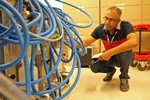A day in the life of a … biomedical engineering specialist

When asked what makes him great at his job, Chetanand Gopaul proudly answers, “I’m a good listener.” Originally from Mauritius, Gopaul has been working for the McGill University Health Centre (MUHC) for over 10 years. After graduating with an electronic engineering degree from the Polytechnic of North London, Gopaul returned home to pursue a career as a consultant for an engineering firm. “I enjoyed my job, but my brother-in-law came by my house every day to tell me they were hiring engineers at the local hospital,” he recalls. “After weeks of brushing him off, I decided to go see what all the fuss was about.”
After meeting with the head of the biomedical engineering department, Gopaul was offered a job on the spot but with one drawback: the salary was half his current pay. “The biomedical director told me he couldn’t offer me more, but that it would be the best decision I’d ever make,” he says. Undecided, Gopaul left the hospital and returned to work, but had a change of heart on his way home. “I still don’t know what came over me, but I decided to take the job. It was the definitely the best decision I ever made.”
Fast-forward 20 years and Gopaul still loves the field of biomedical engineering; in fact he even went back to school to complete a post-graduate degree in biomedical engineering at Keele University. “My work impacts the amazing care we offer our patients,” he says. “I get to be part of something very special.” Based at the Glen site, Gopaul’s work involves replacing and buying new pieces of equipment for the Montreal Children’s Hospital. “I work on different projects every day for the hospital and the Children’s Foundation, like doing research for the procurement of new medical equipment,” he says. On average, the MUHC orders approximately 5,000 new pieces of equipment every year. “On a daily basis, seven new pieces of equipment come through our doors at the Glen,” Gopaul says.
Situated on BS2, the department is home to five biomedical specialists, also known as professionals, and 20 technicians, but there are also biomed teams at the Montreal General, Lachine and Montreal Neurological hospitals. “Working for a teaching hospital has major benefits, because we always ask for and recommend the best biomedical technology available,” he says. “It makes for an exciting work environment because technology is constantly evolving and it’s being used more and more in patient care.”
When a piece of equipment breaks down, and no longer performs at a high standard, or is beyond economical repairs – meaning it makes more sense financially to replace it than to repair it - the END user, which is the name given to the person requesting the equipment, fills out a biomedical request form. The project is then assigned to one of the biomedical specialists. “I prepare the technical specifications based on the END user’s request. This is the time when I begin my research,” he says. “I look at the latest technology available and determine what fits our needs and what’s the best value for our money.”
Technicians, also known as bench workers, maintain, repair, and calibrate the medical equipment. Mobile pieces of equipment are wheeled down to their office space for repairs, while non-mobile fixtures, such as a microscope mounted to a ceiling, are fixed on-site. Each technician is assigned to a different area of the hospital. Some work for specific specialties, while others are assigned to support entire departments. If something cannot be repaired or is beyond economical repair, the technicians will advise the END user to fill out an equipment request form for replacement. In other cases, if a product can be repaired but is beyond their expertise, it goes back to the manufacturer.
“Our department is about teamwork. As professionals we wouldn’t be able to do our job properly without the technicians, and vice versa,” says Gopaul. If equipment is still functional, but no longer meets the MUHC’s standards, it is offered to other organizations free of charge. “They either send it to other hospitals in Quebec or countries where there’s a need for it or to CEGEPs for training purposes.”
Over the last 10 years, Gopaul says the biomedical industry has changed tremendously. Through research and competition, biomed companies are now able to supply high-quality, cutting-edge technology at a reasonable price. “The market has become so competitive over the last few years. In the past, we used to deal with one manufacturer who had complete monopoly over the entire market,” he says. “Now we’re able to get better value for our money. In some cases we’re now paying $25,000 instead of $60,000 for the same piece of equipment. These companies are constantly outdoing each other. It’s impressive to see.”
One piece of biomed equipment that truly impressed him recently is the MCH’s operating microscope for cranio-surgery. “This microscope does all the calculations by itself!” he says. With all these new technologies on the market, Gopaul keeps himself up-to-date by constantly reading and researching new products. “If I come across an interesting piece of equipment that I think we could benefit from, I will approach an END user and suggest they look into it.”
“I love my job because when I look around this place I know I’ve worked hard at making sure we get to work with the best technology available. I wouldn’t want to be doing anything else.”



